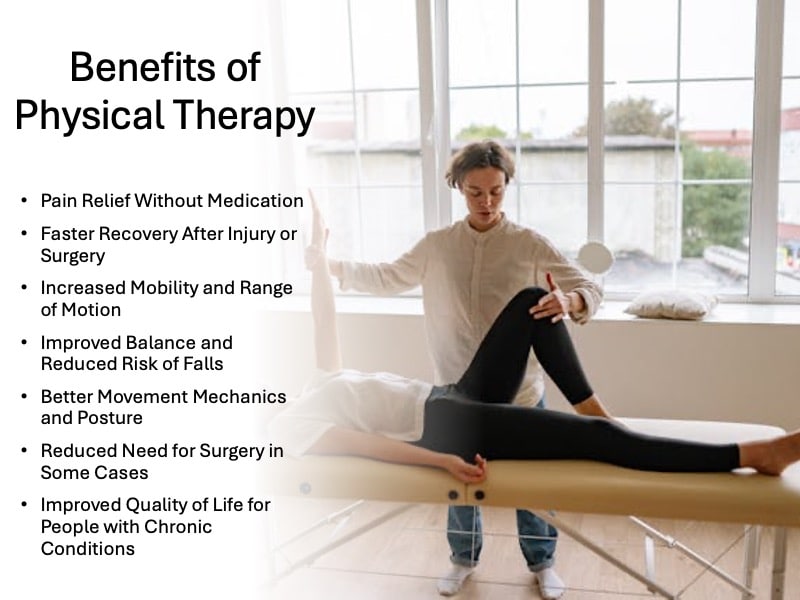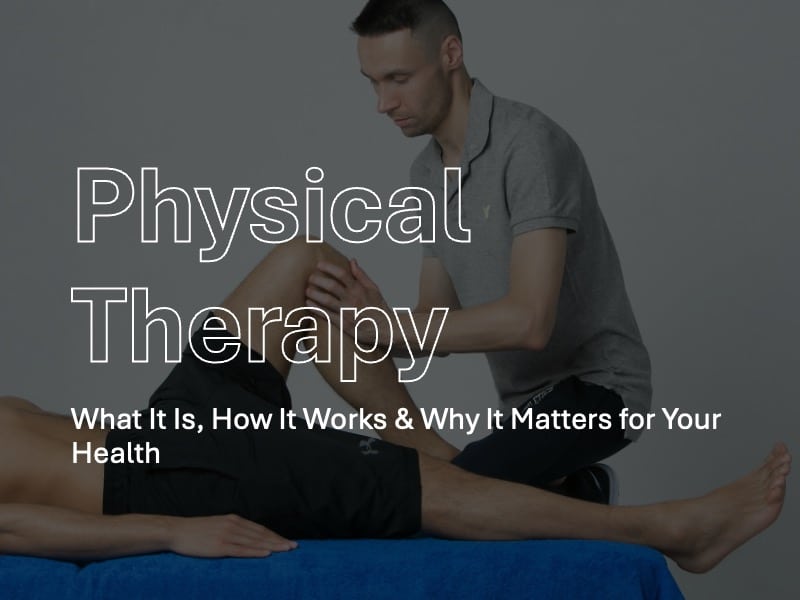Physical Therapy: What It Is, How It Works & Why It Matters for Your Health
Physical therapy is a healthcare specialty that helps people restore movement, improve function, and reduce pain through targeted exercises, manual techniques, education, and therapeutic modalities.
As I’ve learned through my career as a professional athlete, physical therapy plays a key role in recovery from injury, surgery, or chronic conditions and is often used as a non-invasive alternative to medications or surgery.
As a professional basketball player, I’ve worked with numerous physical therapists (also known as physiotherapists in Europe and many other parts of the world) for a wide range of issues.
I’ve done extensive physical therapy for my knee after a serious car accident in December 2024, as well as treatment for my back and shoulder throughout my career.
My wife has also relied heavily on physical therapy for her neck and back following the same accident.
Because of these experiences, I regularly recommend physical therapy to my parents and friends dealing with nagging pains or chronic conditions.
I strongly believe in its ability to improve movement quality and restore function, which ultimately leads to a better, more active life.
Whether you’re recovering from surgery, managing knee pain from arthritis, or seeking to prevent future injuries, physical therapy offers a science-based and personalized approach to improve physical function and quality of life.
What Is Physical Therapy?
Physical therapy (PT) is a branch of rehabilitative healthcare provided by licensed physical therapists.
These professionals assess movement patterns, identify dysfunctions, and design customized treatment plans to promote recovery and optimize mobility.
Treatment may involve a mix of therapeutic exercise, soft tissue mobilization, stretching, strength training, neuromuscular re-education, and pain-relieving modalities such as electrical stimulation or ultrasound.
What Can Physical Therapy Help With?
Physical therapy can address a broad range of conditions across all stages of life. Common reasons people seek physical therapy include:
- Orthopedic injuries (sprains, fractures, back pain)
- Post-operative rehabilitation (knee replacements, rotator cuff repair)
- Neurological disorders (stroke, Parkinson’s disease, multiple sclerosis)
- Chronic pain (fibromyalgia, sciatica)
- Pediatric developmental delays
- Pelvic floor dysfunction
- Sports performance optimization and injury prevention
Physical therapists also help individuals improve their balance, coordination, posture, and overall mobility, particularly after prolonged periods of inactivity or hospitalization.
Benefits of Physical Therapy

Working with a licensed physical therapist offers both short-term and long-term health benefits, including:
- Pain relief without medication
- Faster recovery after injury or surgery
- Increased mobility and range of motion
- Improved balance and reduced risk of falls
- Better movement mechanics and posture
- Reduced need for surgery in some cases
- Improved quality of life for people with chronic conditions
These benefits make physical therapy a vital tool for athletes, aging adults, and individuals seeking to improve mobility, recover safely, or manage pain more effectively.
Pain Relief Without Medication
Physical therapy is a valuable tool for managing chronic pain, offering long-term relief through movement correction and tissue healing.
When chronic pain becomes too much to manage on your own, seeing a licensed physical therapist can provide a safer, more sustainable path to recovery.
Physical therapists employ techniques such as soft tissue mobilization, dry needling, and therapeutic exercises to help naturally reduce pain.
Advanced options such as IMS dry needling can provide significant relief for chronic pain, while also improving movement and quality of life.
This approach can decrease the need for over-the-counter or prescription medications, which often come with unwanted side effects or risks of dependency.
Faster Recovery After Injury or Surgery
Targeted physical therapy accelerates healing by promoting circulation, reducing inflammation, and retraining muscles after injury or surgery.
With consistent sessions, many people regain strength, coordination, and confidence more quickly than they would with rest alone.
Increased Mobility and Range of Motion
Whether you’re recovering from a joint replacement or simply dealing with stiffness, physical therapy helps improve how your body moves.
Therapists use progressive stretching, manual techniques, and resistance exercises to restore lost flexibility and joint function.
Improved Balance and Reduced Risk of Falls
Physical therapy for seniors focuses heavily on fall prevention and restoring confidence in movement, which can significantly enhance independence and safety at home.
For individuals at risk of falling, physical therapists offer balance training, gait re-education, and proprioceptive exercises to improve the neuromuscular system.
These strategies are especially valuable for older adults or individuals with neurological disorders.
Better Movement Mechanics and Posture
Poor posture and faulty movement patterns often contribute to chronic pain and recurring injuries.
Physical therapists assess biomechanics and teach you how to move more efficiently, helping you protect your joints and maintain good posture in daily life.
Some physical therapists specialize in unique disciplines, such as dance physiotherapy, which targets the specific movement patterns and injury risks associated with dancers to improve performance, prevent injuries, and support long-term joint health.
Reduced Need for Surgery in Some Cases
In conditions like degenerative disc disease, rotator cuff injuries, or meniscus tears, physical therapy can serve as an effective conservative treatment.
Strengthening surrounding muscles and improving mobility may reduce pain and restore function enough to avoid surgical intervention.
For example, individuals looking to get healthy shoulders and eliminate shoulder pain after an injury can often achieve significant improvement through physical therapy, potentially avoiding the need for surgical intervention altogether.
Improved Quality of Life for People with Chronic Conditions
For individuals with long-term health issues such as arthritis, fibromyalgia, or Parkinson’s disease, regular physical therapy improves endurance, function, and independence.
It empowers people to manage symptoms more effectively and stay active in their daily lives.
Does Physical Therapy Work?
Yes, physical therapy is highly effective when guided by a qualified therapist and done consistently.
Research shows that physical therapy can significantly reduce pain, restore mobility, and improve function in both acute and chronic conditions (Foster et al., 2018).
Many patients report an improved quality of life and a decreased reliance on pain medications after completing a course of therapy.
How Much Does Physical Therapy Cost?
The cost of physical therapy can vary based on location, session length, and whether or not you’re using insurance.
On average in the U.S., a physical therapy session without insurance ranges from $75 to $200 per visit.
Factors that influence cost include:
- Clinic type (hospital-based vs. private practice)
- Frequency of visits (typically 1–3 times per week)
- Duration of treatment plan (usually 4–12 weeks)
Patients using insurance generally pay a copay of $20–$50 per session, depending on the plan.
Does Insurance Cover Physical Therapy?
Most private health insurance plans cover physical therapy, particularly when it’s medically necessary and prescribed by a doctor.
However, insurance coverage for physical therapy often includes:
- A limited number of sessions per year
- Requirement for pre-authorization
- Provider network restrictions
It’s important to contact your insurance provider to understand your specific benefits, deductibles, and copays.
Does Medicare Cover Physical Therapy?
Yes, Medicare Part B covers outpatient physical therapy when it is medically necessary. As of recent guidelines:
- You typically pay 20% of the Medicare-approved amount after meeting your deductible.
- Therapy must be provided by a Medicare-certified therapist or facility.
- No hard cap limits currently exist, but Medicare requires progress notes and continued justification for care.
This makes PT an accessible and effective part of senior health care under Medicare.
How Long Does Physical Therapy Take?
The duration of a physical therapy program depends on the individual’s condition, goals, and adherence to the treatment plan. On average:
- Acute injuries: 4–6 weeks of treatment
- Post-surgical rehab: 8–12+ weeks
- Chronic conditions: Ongoing care, often phased out as independence improves
Some people feel improvement after just a few sessions, while others may need several months of consistent work to see substantial changes.
Final Thoughts: Is Physical Therapy Right for You?
Physical therapy is a safe, evidence-based, and highly individualized approach to healing, improving mobility, and managing pain.
Whether you’re recovering from injury, managing chronic pain, or striving to prevent future problems, working with a licensed physical therapist can dramatically improve your physical well-being and long-term health.
Before beginning treatment, speak with your healthcare provider or a physical therapist to determine the best path forward based on your specific needs.
This website does not provide medical advice. This website site does contain affiliate links, and purchases may earn a commission.
Read my Medical Disclaimer, Review Disclaimer, and Publishing Policies for more details. Use of this site indicates acceptance of these terms.



